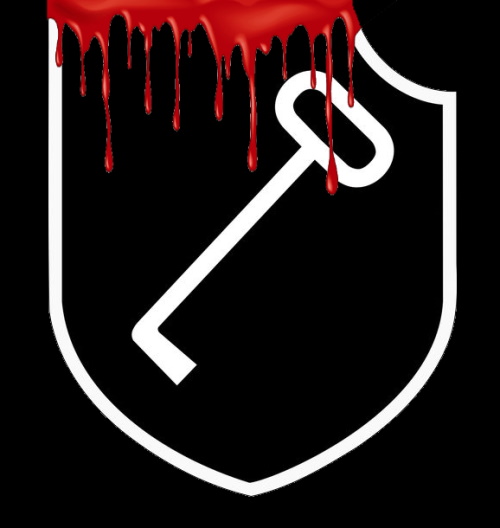 Routes and Atrocity Incidents, Narratives, Route Description
Routes and Atrocity Incidents, Narratives, Route Description
Units of the Kampfgruppe Peiper proceed generally on the following itinerary: from the forest around Blankenheim, Germany, on Dec 16, to Dahlem, Hallschlag, Scheid, Losheim, then into Belgium during the night of the Dec 16/17, in Lanzerath, Honsfeld, which was reached by the point at approximately 0700 Dec 17. The next town was Büllingen which was reached about 1100, Dec 17, then to Schoppen and Thirimont which was reached by the point about noon Dec 17. The Kampfgruppe got to the Five Points Crossroads (Baugnez) which was reached at about 1400 the same day, then to Ligneuville, and then to Stavelot which was reached at about 2200. In the morning of Dec 18 at about 1000, Stavelot was attacked and the Kampfgruppe proceeded to the next village, Trois Ponts, then to La Gleize, to Cheneux, and to Stoumont on Dec 19, and back to La Gleize.
Honsfeld
Kampfgruppe Peiper proceeded without any incidents of interest from the Blankenheim area to the town of Honsfeld in Belgium. American troops assigned to various units of the 612-TDB were located in this area. In the early morning of Dec 17, the Germans attacked the positions occupied by the Americans. In one instance a house containing 18 enlisted men and four officers was surrounded by troops of the 1.SS-Panzer-Division and was in the process of being destroyed by 88-MM guns when a white flag was displayed from a window and firing from both sides ceased. At about 0800 or in the morning of Dec 17 in the vicinity of Honsfeld, members of the 3.SS-Panzer-Company saw 6 to 10 American Prisoners of War’s standing in the front of a house with their arms raised in surrender. The Germans opened fire and killed them.
Bullingen
Shortly before the 3.SS-Panzer-Company arrived at the Army small airfield near Büllingen on Dec 17, six or eight unarmed surrendered American prisoners of war were seen walking along the road toward the rear of the Kampfgruppe. Between the airfield and Büllingen the crew of a half-track belonging to the 3.SS-Panzer-Company fired into two separate groups, each consisting of 5 to 8 unarmed and surrendered American prisoners of war. Other groups were shot by other 3.SS-Panzer-Company men, in the Büllingen vicinity. An American PW, a flight officer was shot to death near Büllingen after he had been interrogated by a man called Preus, commander of the 10.SS-Panzer-Company. In Büllingen, the commander of the 1.SS-Panzer-Company, mentioned to 8-10 unarmed Americans, who were shot. Two American PW’s were shot by the member of the 10.SS-Panzer-Company at about 0800 on Dec 17. In Büllingen, a German soldier (Rieder) of the 9.SS-Panzer-Pioneer-Company shot a woman (Frau Anton Jousten). About a kilometer beyond Büllingen, in the direction of Thirimont, 3.SS-Panzer-Company men shot 6-8 American PWs.

 In the extra-judicial sworn statement dated Jun 26, 1946, signed by the mayor registrar of the Town of Bullingen it is certified that Madame Anton Jousten died in Bullingen on Dec 18, 1944, (the date at which the body was found) and that the list in the registrar’s office contained no other case of death of unknown causes during 1944. In the extra-judicial sworn statement of Monsieur Jousten the husband of Madame Jousten, Anton Jousten stated that his wife was killed on Dec 16, or Dec 17, by American Artillery fire while she was outside her house attempting to flee from combat. He also stated that her body wore the marks indicating that the death was caused by the explosion of an Artillery shell. In this extra-judicial sworn statement from Anton Jousten, the exact wording for the last sentence is the death was caused by the explosion of a granate. Because the word ‘shell’ doesn’t exist in German (shell as an artillery shell), the word in German used is ‘granate’, the War Crime Investigation Team, as well as the War Crime Court, did jump from the German term ‘granate’ to the American term ‘Grenade’. In fact, when Anton Jousten stated that his wife was killed by a ‘granate’ he was meaning an artillery ‘shell’. This just to correct the original text from the archive.
In the extra-judicial sworn statement dated Jun 26, 1946, signed by the mayor registrar of the Town of Bullingen it is certified that Madame Anton Jousten died in Bullingen on Dec 18, 1944, (the date at which the body was found) and that the list in the registrar’s office contained no other case of death of unknown causes during 1944. In the extra-judicial sworn statement of Monsieur Jousten the husband of Madame Jousten, Anton Jousten stated that his wife was killed on Dec 16, or Dec 17, by American Artillery fire while she was outside her house attempting to flee from combat. He also stated that her body wore the marks indicating that the death was caused by the explosion of an Artillery shell. In this extra-judicial sworn statement from Anton Jousten, the exact wording for the last sentence is the death was caused by the explosion of a granate. Because the word ‘shell’ doesn’t exist in German (shell as an artillery shell), the word in German used is ‘granate’, the War Crime Investigation Team, as well as the War Crime Court, did jump from the German term ‘granate’ to the American term ‘Grenade’. In fact, when Anton Jousten stated that his wife was killed by a ‘granate’ he was meaning an artillery ‘shell’. This just to correct the original text from the archive.
Baugnez (Five Points Crossroads)
Elements of Kampfgruppe Peiper arrived at the 5 roads intersection (Five Points Crossroads) in Baugnez, between Malmedy and Ligneuvile, between 1200 and 1400, Dec 17. The Crossroads is located about four kilometers southeast of Malmedy at a point where one road leads down to Malmedy, another to Hedomont, another to Waimes, and another to Ligneuville.  Elements of Kampfgruppe Peiper captured personnel of the American 285-FAOB. German armored vehicles, a tank, and half-tracks were moved into position to fire upon the Americans. German armored vehicles proceeded along the road opposite this group of American prisoners. This unwanted shooting of surrendered and unarmed prisoners of war was carried out by element of various units of the Kampfgruppe Peiper.
Elements of Kampfgruppe Peiper captured personnel of the American 285-FAOB. German armored vehicles, a tank, and half-tracks were moved into position to fire upon the Americans. German armored vehicles proceeded along the road opposite this group of American prisoners. This unwanted shooting of surrendered and unarmed prisoners of war was carried out by element of various units of the Kampfgruppe Peiper.
Ligneuville
After leaving the Crossroads the German column resumed its advance toward Ligneuville. At this place, Hotel du Moulin, about 1600, Dec 17, 8 American prisoners of war were shot by personnel of the 9.SS-Panzer-Company.
Ligneuville to Stavelot
A troop carrier and personnel guarded 15 American Prisoners of War. According to reports, they shot the prisoners.
Wereth
On Dec 17, the spearhead of 3.SS-PzAA1 (Kampfgroup Knittel – 1.SS.Pz.Div LSSAH) entered the little town of Wereth and found eleven black American soldiers who surrendered to them. Some were wounded but this didn’t stop the SS from marching them to a field during a severe blizzard and shooting them in cold blood. All were members of Btry C 333-FAB. The bodies were found covered in snow two months later when the villagers directed members of the 99th Infantry Division to the site.
Stavelot
On Dec 21, when certain units of the Kampfgruppe Peiper were engaged by American Tanks, Sturmbannführer Gustav Knittel gave the order to shoot 8 unarmed and surrendered American prisoners. This took place at the edge of the woods near a single house located near the bridge over the Amblèbe River, 3000 M west of Stavelot. Gustav Knittel was in charge of the 1.SS-Recon-Battalion. Units of Kampfgruppe Peiper continued their advance to Stavelot and reached there on Dec 18. Some Belgian civilians were fired upon by one of 4 Tanks parked on the roads leading to the Hospital. On the outskirts, on the evening of Dec 18, two civilians 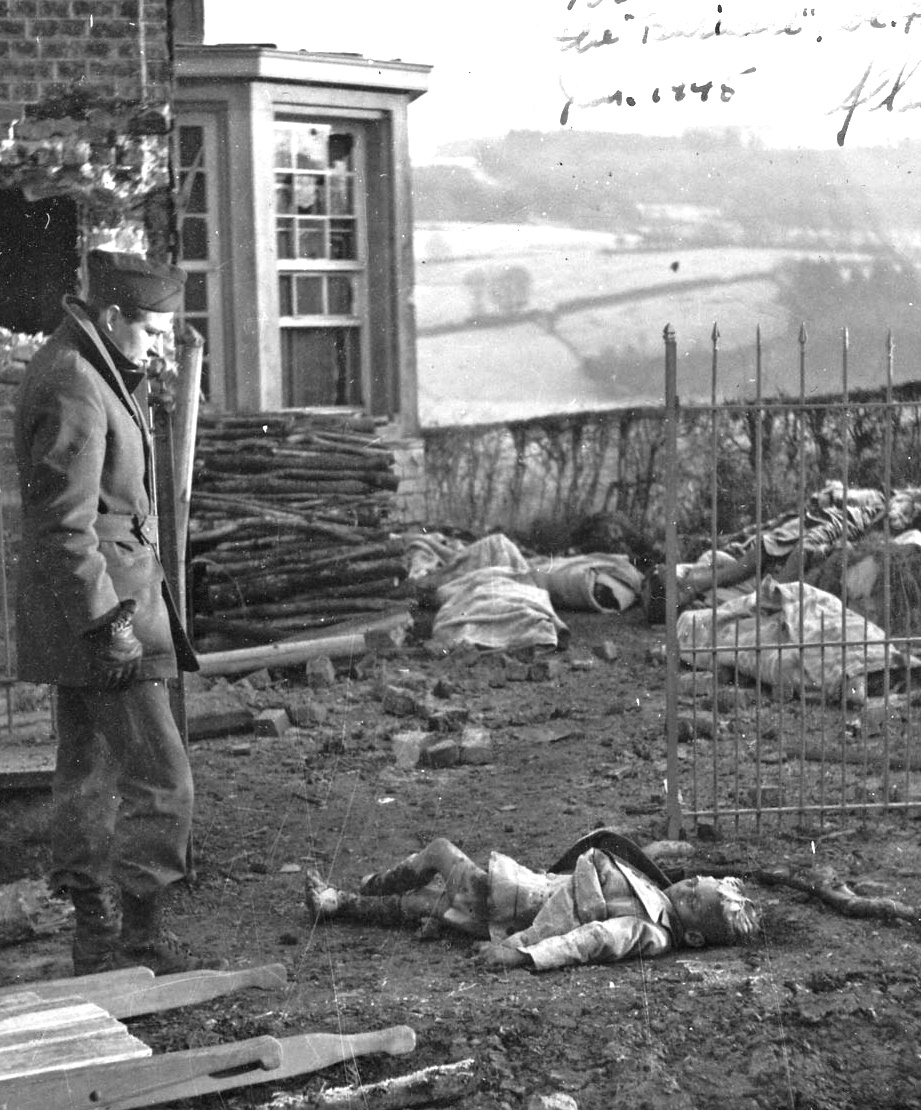 were shot by members of the 6.SS-Panzer-Company. Still on Dec 18, at the edge of Stavelot on the road to La Gleize, personnel from the vehicle of the commander of the 1.SS-Panzer-Company, fired upon a woman. On Dec 19, Units of Kampfgruppe Peiper shot other Belgian civilians.
were shot by members of the 6.SS-Panzer-Company. Still on Dec 18, at the edge of Stavelot on the road to La Gleize, personnel from the vehicle of the commander of the 1.SS-Panzer-Company, fired upon a woman. On Dec 19, Units of Kampfgruppe Peiper shot other Belgian civilians.
Cheneux
Some units of Kampfgruppe Peiper proceeded to Cheneux and vicinity where they were subjected to a very severe air attack. American prisoners were shot a few meters from the vehicle in which the commanding officer of the Kampfgruppe Peiper was riding. On the evening of Dec 18, 30 to 40 Americans were collected on the outskirts, and German personnel from five Tanks and half-track fired upon them.
La Gleize
Among the elements of the Kampfgruppe Peiper entering the town about 1500 on Dec 17, were units of the 11.SS-Panzer-Grenadier-Company, 9.SS-Panzer-Pioneer-Company, and 3.SS-Panzer-Pioneer-Company. American unarmed and surrendered prisoners of war were shot at the town church. During the period of Dec 18 to Dec 23, other units of the Kampfgruppe Peiper entered La Gleize, departed therefor, and returned thereto. American prisoners were frequently killed by units of Kampfgruppe Peiper during these 6 days. A pasture in the vicinity of the schoolhouse was the scene of some above things. Some shootings were carried out with the approval of Joachim Peiper.
Stoumont
On the morning of Dec 19, after various units of the Kampfgruppe Peiper had left Ligneuville, Stavelot and La Gleize, the column arrived in Stoumont, and shooting took place. While a Fallschirmjäger was escorting 7 prisoners of war to the rear of the German lines, elements of the 11.SS-Panzer-Company took them over and shot them. On the same day (Dec 19) elements of the 3.SS-Panzer-Pioneer-Company shot also prisoners of war. Elements of the 9.SS-Panzer-Company were sawed with prisoners of war. On Dec 19, 15 to 20 prisoners of war were killed by the crew of a Panther at the point next to a house which was thought to be the  CP of SS-Sturmbannfuehrer Peiper. Also, 3 other prisoners were killed in Peiper’s presence. Elements of the 2.SS-Panzer-Company also killed men in Stoumont. 15 to 25 American prisoners were guarded by German paratroopers when fired upon by crews of several German Tanks. An interview pointed this fact out: while some of us were walking American prisoners to the rear, these SS started shooting like hell on the prisoners and they even wounded one of us. We were about to call the others Fallschirmjäger and ready to shoot back at the SS when the fire ceased. At about 1400, on Dec 19, elements of the 2.SS-Panzer-Company reached the most westerly point attained during the offensive, approximately 2000 M west of Stoumont. There, Machine Gunners of 2 Tanks fired at some 15 unarmed prisoners of war.
CP of SS-Sturmbannfuehrer Peiper. Also, 3 other prisoners were killed in Peiper’s presence. Elements of the 2.SS-Panzer-Company also killed men in Stoumont. 15 to 25 American prisoners were guarded by German paratroopers when fired upon by crews of several German Tanks. An interview pointed this fact out: while some of us were walking American prisoners to the rear, these SS started shooting like hell on the prisoners and they even wounded one of us. We were about to call the others Fallschirmjäger and ready to shoot back at the SS when the fire ceased. At about 1400, on Dec 19, elements of the 2.SS-Panzer-Company reached the most westerly point attained during the offensive, approximately 2000 M west of Stoumont. There, Machine Gunners of 2 Tanks fired at some 15 unarmed prisoners of war.
Wanne
On Dec 20, and/or Dec 21, some elements of Kampfgruppe Peiper were in Wanne. They were units of the 1.SS-Panzer-Regiment, 7.SS-Panzer-Company, and PWs were also fired upon.
Lutrebois
On Dec 31, certain units of the 9.SS-Panzer-Company were in that town. Again, PWs were killed.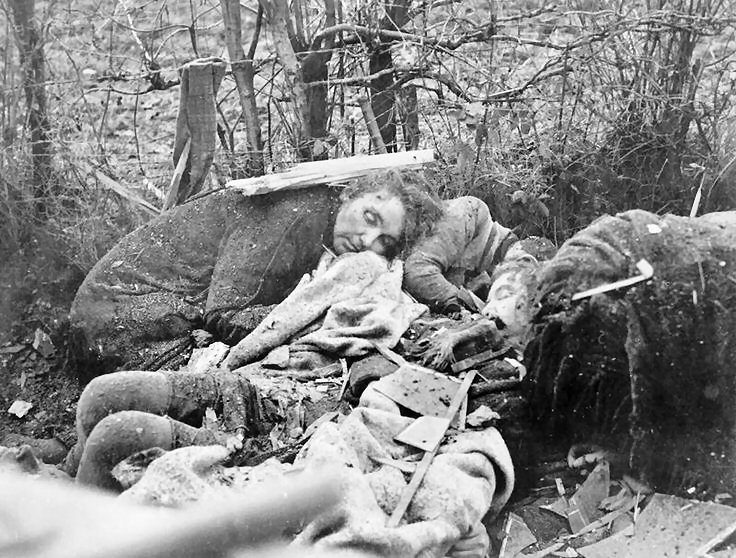
Trois Ponts
Civilians and 11 American Paratroopers were shot to death. No identification of the units (German) was given.
Petit-Thier
Peiper was in his HQs on Jan 10 or Jan 13, 1945, in a castle near the town. SS Sturmbahnfuehrer Kurt Sickel was with him. There is no need to say what happened.
 This entire original translation is nothing else than a mess. It is such bad work that I was, several times, lost in the text I was typing for the readers. There is no way to release such a kind of text and I will have to correct the entire testimony and the entire report according to common sense and simple military activity. Remember that I am working with a very bad xerox of the already translated testimony (as usual). So I will have to retype the entire text but first, re-translate it from English to German then back to English to get the real testimony or at least to have the correct sentence that Peiper wrote in this period of time.)
This entire original translation is nothing else than a mess. It is such bad work that I was, several times, lost in the text I was typing for the readers. There is no way to release such a kind of text and I will have to correct the entire testimony and the entire report according to common sense and simple military activity. Remember that I am working with a very bad xerox of the already translated testimony (as usual). So I will have to retype the entire text but first, re-translate it from English to German then back to English to get the real testimony or at least to have the correct sentence that Peiper wrote in this period of time.)
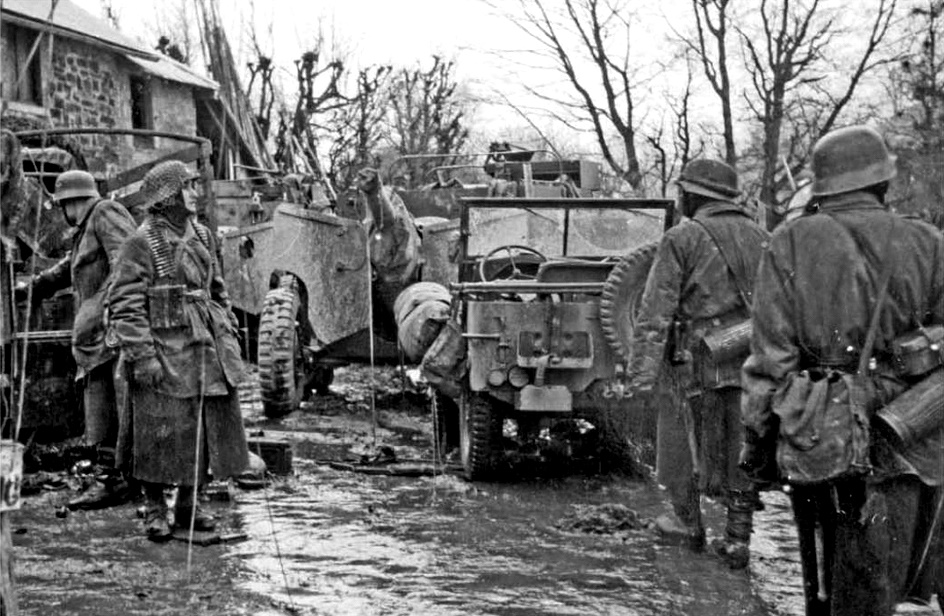 SS-Obersturmbannführer Joachim Peiper
SS-Obersturmbannführer Joachim Peiper
Atrocity Trial Testimony
He was convicted in 1946 as a participant in the Malmédy Massacre, Dec 17-20, 1944, and his 81-page direct testimony, plus the cross and redirect, explained some tactical operations of Kampfgruppe Peiper. Because he was a defendant, his remarks need evaluations. They were more detailed in some respects than the three Peiper interviews possessed by the Foreign Studies Branch, OCMH, thus of probable value. The following extracts of the tactical data will be connected into as orderly a sequence as possible, but the interrogation was not always chronological.
A – Direct Examination by Lt Col John S. Dwinell, Assistant Defense Counsel
(December 14) Blankenheim Forest. We were called for a Regimental Conference at 1600, CP in the Blankenheim Forest. Attending were: CG 12.Volksgrenadier-Division, Generalmajor Gerhardt Engels, CO 1.Panzer-Battalion, SS-Sturmbannführer Werner Poetschke; CO 2.Panzer-Battalion, SS-Obersturmbannführer Heinz von Westernhagen – (CO Heavy Tank Battalion (Tiger) .501); CO 3.Panzer-Battalion, Sturmbannführer Josef Diefenthal (2.Panzer.Regiment 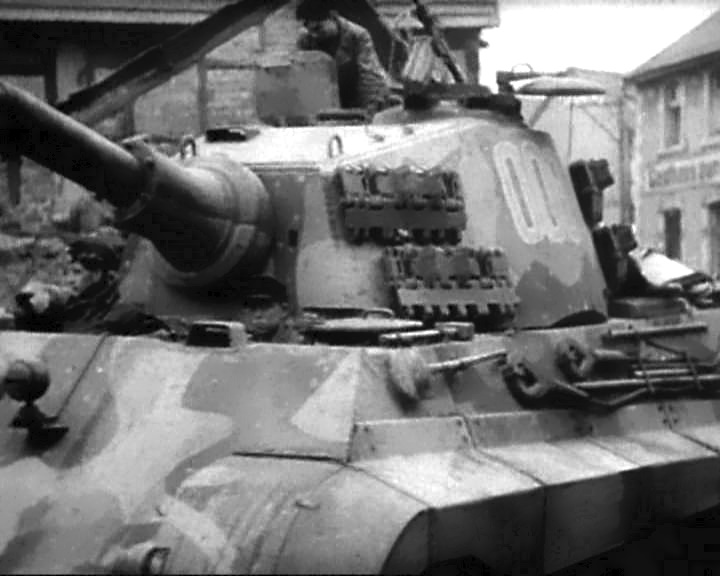 attached); Adjutant and Signal Officer 2.Artillery.Battalion & Flak Battalion.
attached); Adjutant and Signal Officer 2.Artillery.Battalion & Flak Battalion.
The attack order of the 1.SS-Panzer-Division was read. Then, subsequently, I had a conference about purely tactical matters in which I explained that we had to make an attack through a terrain unsuitable for tanks, especially for the Mark V Panthers and the Mark VI Tigers, that the only chance of success depended upon speed, surprise and relentless commitment of person and material. I explained the basic thought to form a spearhead (Aufklärung Abteilung) which would consist of the 1.Panzer-Battalion, the 3.Panzer-Grenadier-Battalion, Panzer-Flak, and Panzer-Pioneer. Composed in such a manner, it should be suitable because of its speed, armor, and firepower to solve all coming problems.
This group should without regard advance, should not pay attention at unimportant enemy goals not booty not prisoners of war, and the task of this group should be finished then if only one single Mark IV Panzer was to reach the Meuse River even without a crew inside. That was clear to me and I carried it thought and I explained it because of the very difficult terrain and because of the regrouping of the enemy this groups should be entirely rubbed and that it would then depend that the Mark VI Tigers Battalion would be sent behind in a closed orderly march in order to after the 1.Battalion were rubbed out, take over the heavy fighting itself. And that was according to my judgment the area of the slopes of the Ardennes into the area of the Meuse.
In other words, the 1.Battalion received a very desperate task, which I explained very clearly to the officers. Ammunition was to be used sparsely because of re-supply. We had only one  tankful of fuel in each tank because I could not figure on reinforcement and had to depend to supplement my vehicle with enemy fuel. As to the point, its decisive part was the march order. Bad narrow roads would make an order of march change later, therefore the composition was carefully planned. I’ve talked over two hours with the commanders about this. The entire band of march (Kampfgruppe) was about 25 Km long. Because of the fact that the broadcast was very limited, due to the bad terrain features, I had to choose a place for myself almost in the center if I wanted to have an essential point of inference. Divided column into section. SS-Sturmbannführer Werner Poetschke commanded the spearhead of the group, consisting of his 1.Panzer-Battalion, the 3.Panzer-Grenadier-Battalion, the 9.Panzer-Pioneer-Company, and the Regimental Flak Company.
tankful of fuel in each tank because I could not figure on reinforcement and had to depend to supplement my vehicle with enemy fuel. As to the point, its decisive part was the march order. Bad narrow roads would make an order of march change later, therefore the composition was carefully planned. I’ve talked over two hours with the commanders about this. The entire band of march (Kampfgruppe) was about 25 Km long. Because of the fact that the broadcast was very limited, due to the bad terrain features, I had to choose a place for myself almost in the center if I wanted to have an essential point of inference. Divided column into section. SS-Sturmbannführer Werner Poetschke commanded the spearhead of the group, consisting of his 1.Panzer-Battalion, the 3.Panzer-Grenadier-Battalion, the 9.Panzer-Pioneer-Company, and the Regimental Flak Company.
(December 15) I.SS-Panzer-Corps conference with SS-Obergruppenführer Hermann Priess. Present also was SS-Obersturmbannführer Otto Skorzeny who discussed Operation Greiff and the plan of his Panzer-Brigade 150, whose CO, SS-Obersturmbannführer Willi Hardieck, which was to work in conjunction with Peiper’s Kampfgruppe meanwhile accomplishing his own engagement for a kind of obscure mission. Pieper had a long discussion with Hardieck about the mission. Another Regimental conference on the evening, Regimental order largely based upon divisional, finished at about midnight.
